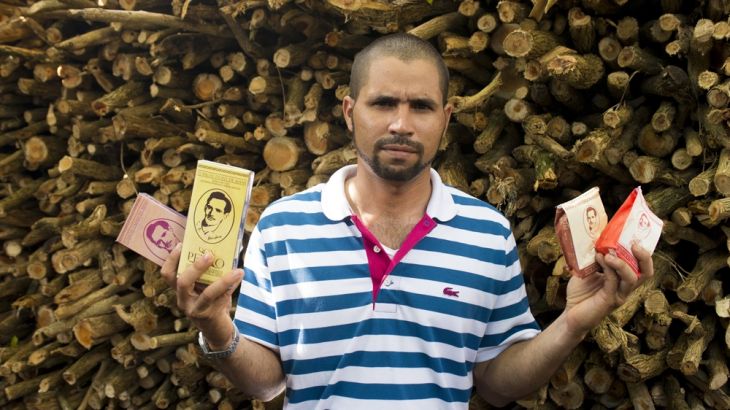
Havana: Cuba’s Food Revolution
We visit Havana to find out how politics affects food and how recent changes are being reflected in Cuban cuisine.
After more than five decades of enmity and trade embargo, the United States restored diplomatic relations with the neighbouring island nation of Cuba in July 2015.
The trade embargo is still in place but as Havana’s relationship with Washington changes, Cuban Americans are increasingly sending financial support to relatives on the island and a new generation of restaurants is opening in Cuba.
Keep reading
list of 4 itemsUS returns ancient artefacts looted from Cambodia, Indonesia
Mandela’s world: A photographic retrospective of apartheid South Africa
Portrait by Gustav Klimt sells for $32m at Vienna auction
Since Raul Castro, the Cuban President, introduced reforms in 2011, tourism is growing and – although the majority of Cubans still work for the state – it is now easier than ever for people to start their own businesses.
Many have chosen to put their efforts into setting up paladares – small restaurants, often run from someone’s home. The most lucrative paladares are those that cater to the growing number of tourists, and this has led both to a reinvention of traditional Cuban dishes and the development of a new fusion cuisine.
Others provide for their fellow Cubans, still living on very low salaries, nutritious meals at ultra-low prices. We see the challenges of getting the simplest ingredients and how state food subsidies remain essential to enable many people just to survive.
AJEats meets Cubans who are pushing their country’s cuisine forward, and others who are providing simple, healthy dishes to those who survive on state salaries.
PRESENTER’S VIEW
By Gerald Tan
I love food. I love making it, tasting it, and talking about it.
The gastronome in me finds joy in discovering new flavours and figuring out ways to transform ingredients. But the inquisitive writer in me always wants to delve deeper and find out about the stories behind the food. Because what we eat, how we eat it, and why, is fundamental to our sense of belonging. It can speak of national identity, inform us about who we are, and where we’ve been.
During my trip to Havana, I had the great fortune of meeting fellow food blogger Alain Gutierrez. He is the face behind A Taste of Cuba, a web journal of recipes and restaurant reviews around his home city. What sets his blog apart are his personal anecdotes on how dishes relate to his culture, such as the simple rice and beans called “moros y christianos”, a reference to the Moors and Christians who shaped Spanish history. He also interviews chefs across Cuba who are trying to preserve their culinary heritage. What’s not stated explicitly, though, is that they are doing all this while enduring punishing sanctions.
It was eye-opening going shopping with Alain at fresh markets, especially those supported by the government. These stores offer staples such as meat, rice and coffee at highly subsidised prices. But there’s a catch – each Cuban can only get a limited number of these items based on a ration card known as “la libreta”. Although the rations aren’t enough to fulfil one’s daily nutritional needs, they certainly help.
Then came another problem. We passed so many stores with empty shelves and idle workers. Alain explained that these state-funded shops hadn’t received any new shipment, but the workers naturally still had to show up to work.
Getting supplies is a daily challenge in Cuba. People just don’t know what they’ll be able to find in the shops on any given day, so planning meals is done by serendipity. And it’s not just food. Even pens and toilet paper can turn out to be scarce commodities. In spite of these difficulties, the Cubans I came across seemed to celebrate life, going about their day with optimism and verve.
Alain described it best when he said: “There are lots of problems in Cuba. People are mostly poor. It’s hard to get everything we want. But we cope.”
MEET THE PEOPLE SHAPING HAVANA’S FOOD
Alain Gutierrez, the food blogger
![Alain Gutierrez [Al Jazeera]](/wp-content/uploads/2015/12/627dcf136dc84217b50a846b8ded0f35_18.jpeg)
Alain is seldom without his camera. An avid photographer, he has channelled his passion for pictures and food into a beautifully crafted blog on Cuban cuisine.
His heavy web presence is rare, given Cuba’s high cost of internet ($2.50 an hour) compared with average salaries ($20 a month). Rarer still is his intimate knowledge of Havana’s dining scene; he knows all the best places to suit any budget.
Alberto Gonzalez Caballos, the baker
![Alberto Gonzalez Caballos [Al Jazeera]](/wp-content/uploads/2015/12/6b4445c5782246a4920a792fc079ea08_18.jpeg)
www.alloggioacuba.net/salchi-pizza.html
The wave of migration in Cuba is largely one way: out. Alberto represents a new breed of Cubans returning to the country armed with skills and experience gained abroad.
A celebrated chef, he earned a Michelin star during his 15 years in Italy. He now runs a bakery in a working-class neighbourhood of Havana and tries to foster healthy eating habits, especially among those who can’t afford it.
Idalino Sanchez Pulido, the CDR coordinator
![Idalino Sanchez Pulido [Al Jazeera]](/wp-content/uploads/2015/12/51f4290f76554368844a0064c9c725f8_18.jpeg)
Sanchez is a well-known face around Old Havana. He holds the title of Area Coordinator for the Committees for the Defence of the Revolution (CDR), an elaborate network of neighbourhood organisations designed to ensure order across the country.
He is there to help the many residents and CDR presidents under his wing and acts as a point man for the Communist Party of Cuba.
Follow Gerald Tan on Twitter @GeraldoTan & on Instagram @boulangerry
Have something you’d like to share? Tweet us at #AJEats